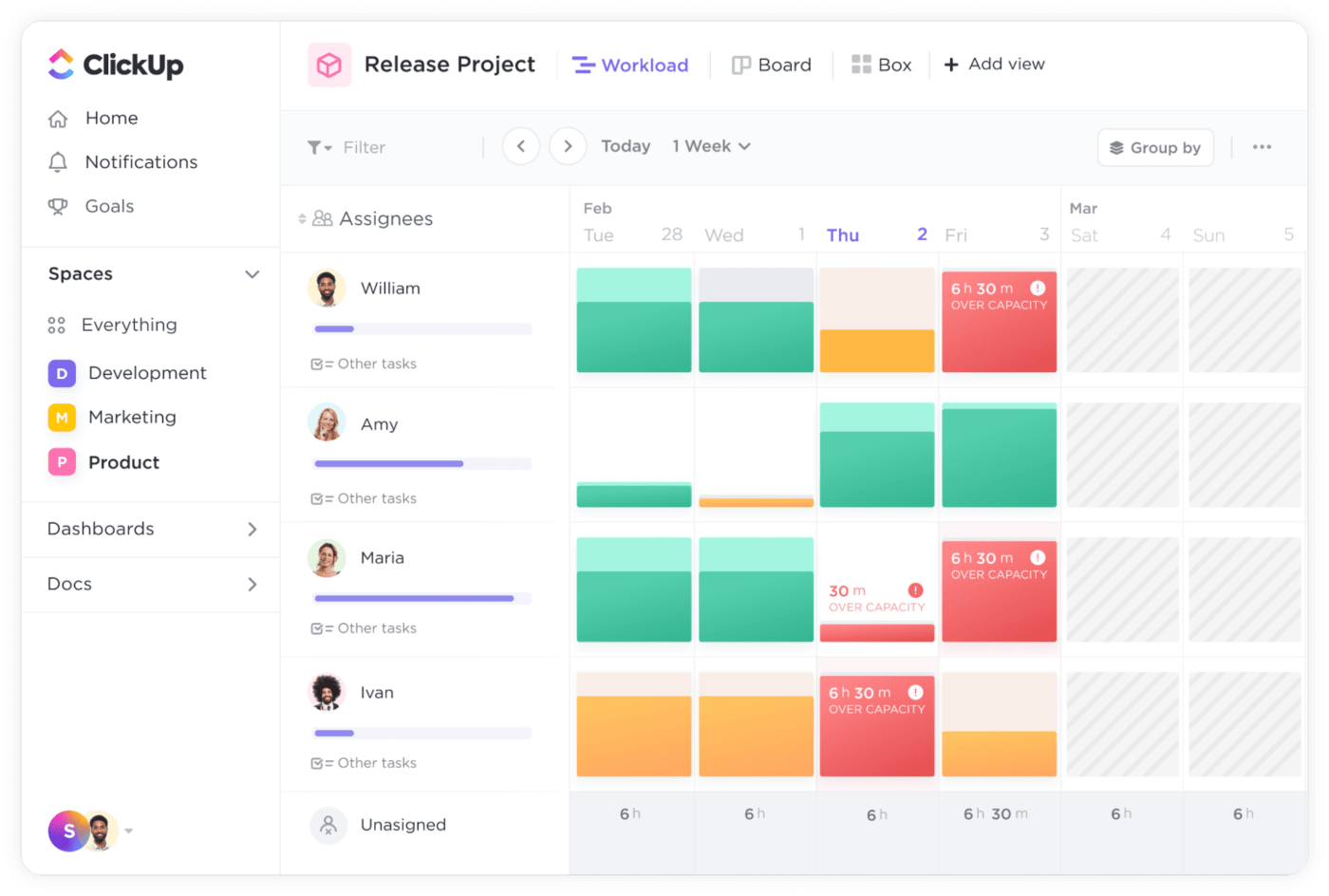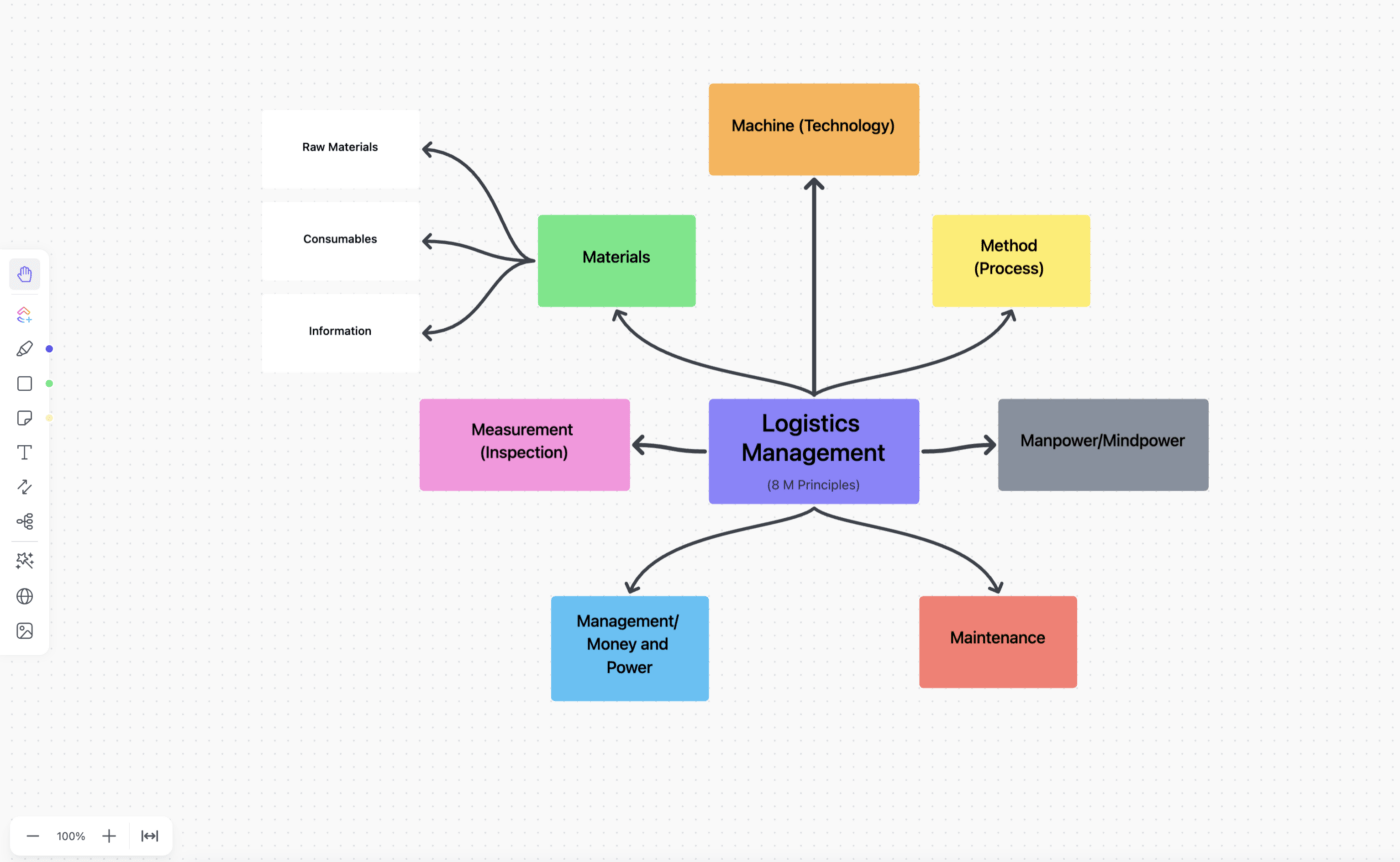لماذا يوجد أي عمل تجاري؟ لتلبية الطلب في السوق من خلال إنتاج وبيع منتج/خدمة مقابل سعر.
إذا تجاوز الطلب الإنتاج، فستفقد فرصة تحقيق الإيرادات. إذا زاد الإنتاج عن الطلب، فلن تتمكن من بيع سلعك، مما يؤدي إلى الهدر والخسائر.
يكمن النجاح في جوهره في قدرة الشركة على التنبؤ بالطلب بدقة وإدارة الطاقة الإنتاجية بشكل مناسب. استراتيجية العمليات وإدارة الموارد على أداة واحدة مهمة لتحقيق ذلك: التخطيط الإجمالي.
ما هو التخطيط التجميعي؟
التخطيط التجميعي هو عملية تصميم معادلة لضمان عدم انقطاع الإنتاج في مصنع التصنيع من أجل تلبية طلب العملاء على المنتجات.
تقوم فرق العمليات بالتنبؤ بالطلب المستقبلي، عادةً لمدة 3-18 شهرًا القادمة، ثم تقوم بالتخطيط الإجمالي لإدارة السعة اللازمة لتلبية هذا الطلب.
لنأخذ مثالاً على ذلك شركة تصنيع سيارات مع توقعات طلب إجمالي يبلغ 150,000 وحدة من ثلاثة أنواع من السيارات على مدار الـ 18 شهرًا القادمة. تقوم الخطة الإجمالية بتصميم تخطيط الإنتاج الصحيح - بما في ذلك العمالة والآلات والخدمات اللوجستية والموارد المالية - لتلبية هذا الطلب.
وعادةً ما يتم تنفيذ تخطيط الإنتاج الكلي لجميع الأنشطة في منشأة الإنتاج، وليس فقط عمليات التشغيل أو المنتجات الفردية. في المثال أعلاه، لا يتم تنفيذ التخطيط الكلي لكل نوع من أنواع السيارات على حدة. يتم إجراؤه دائمًا كمجموع لجميع منتجات الشركة ومرافقها.

بيانات عبء عمل الفريق لمشروع تطوير برمجيات يُستخدم لإجراء تخطيط إجمالي
على الرغم من استخدامه بشكل أساسي في التصنيع وإدارة سلسلة التوريد، إلا أنه يمكن تطبيق التخطيط الكلي أيضًا على أعمال الخدمات.
على سبيل المثال، إذا كان فريق المبيعات الخاص بك يتابع مشروع تطوير برمجيات يحتاج إلى 20 مطورًا خلال العام المقبل، فإن خطتك الإجمالية ستحدد عملية الاستحواذ على هذه الموارد وتدريبها واستخدامها.
ما هي أهداف التخطيط الكلي؟
- تخطيط القدرات لمطابقة الطلب على الإنتاج: يضمن التخطيط الإجمالي أن تكون قدرة المؤسسة مهيأة لتلبية طلب السوق على المدى الطويل
- الإدارة المثلى للموارد: يساعد التخطيط التجميعي على الاستفادة المثلى من الموارد الموجودة، سواء كانت عمالة أو مواد خام أو آلات أو معدل الإنتاج
- الاستقرار في القوى العاملة: يدعم التخطيط التجميعي التوظيف الاستراتيجي والمتدرج، مما يضمن أقصى قدر من الإنتاجية ورضا الموظفين
- القضاء على النفقات العامة غير الضرورية: يضيف شراء المواد الخام غير المستخدمة وتخزينها أو صيانة الآلات غير المستخدمة إلى النفقات العامة غير الضرورية التي يمنعها التخطيط الإجمالي الجيد
فوائد التخطيط الإجمالي
يعد التخطيط التجميعي أداة تشغيلية مهمة وشائعة في قطاع التصنيع وسلسلة التوريد، حيث يقدم العديد من الفوائد.
وفورات في التكاليف
باستخدام خطة تجميع جيدة، يمكنك منع سيناريوهين غير مرحب بهما: السعة غير المستخدمة والطلب غير الملبى. يساعد التخطيط الإجمالي على التنبؤ بالموارد المطلوبة بدقة، مما يمنع الهدر أو النفقات المتعلقة بالتخزين. يمنع مستويات المخزون الزائدة التي قد لا تُباع أو تُباع بخصومات كبيرة.
إدارة أفضل للمخزون
أهم ميزة للتخطيط التجميعي هي أنه يجعل إدارة المخزون فعالة على مستويات متعددة.
- يمنع شراء مواد خام إضافية
- جدولة شراء/تسليم المواد الخام في الوقت المناسب للإنتاج
- يضمن أن يكون خط التجميع في الاستخدام الأمثل
- يزيل الحاجة إلى تخزين المخزون غير الضروري
تحسين إنتاجية الموظفين
يمكن للموظفين تخطيط وتنظيم حياتهم بشكل أفضل مع رؤية واضحة لما ينتظرهم في المستقبل. يمكن للمديرين توظيف الموارد التي يحتاجونها وتدريبهم بشكل مناسب. يمكن لأعضاء الفريق إعادة تدريب/تعزيز المهارات لتلبية الطلب المستقبلي. يمكن للفرق/الأقسام المختلفة التعاون بشكل أكثر فعالية.
والأهم من ذلك، يمكن للمؤسسات تجنب الفصل/التسريح من العمل من خلال التخطيط الكلي الفعال.
اتخاذ قرارات أفضل
تعطي الخطط المجمعة صورة كبيرة للقدرة الإنتاجية للمؤسسة، مما يسهل اتخاذ العديد من القرارات التجارية.
على سبيل المثال، يوازن التخطيط الإجمالي بين طلب السوق وقدرة المؤسسة على التوريد. باستخدام هذه المقاييس، يمكنك اتخاذ قرارات التسعير دون عناء. إذا أظهرت الخطة الإجمالية أنه من المحتمل أن يكون لديك مخزون أكثر من الطلب المتوقع، يمكنك زيادة عروضك الترويجية للتأثير على جانب العميل.
الأهم من ذلك، يوضح التخطيط الإجمالي قراراتك الاستثمارية. فهو يساعد في الإجابة على السؤال، "هل نحتاج إلى الاستثمار في معدات إضافية أو أشخاص إضافيين؟
تماشيًا مع الطلب، يوضح التخطيط الإجمالي كيفية تحسين خطة الإنتاج دون استثمار رأسمالي إضافي.
تحسين المحصلة النهائية
يساعد التخطيط الإجمالي على التحكم في التكاليف المتغيرة مع زيادة كفاءة خط التجميع. وهذا يساهم بشكل مباشر في ربحية المؤسسة.
وعلاوة على ذلك، فإنه يعزز قدرة المؤسسة على التسليم في الوقت المحدد بالكامل (OTIF) - وهو مقياس بالغ الأهمية في سلاسل التوريد بالتجزئة.
على الرغم من فوائده الكبيرة، إلا أن التخطيط الإجمالي ليس بالأمر السهل. فهو يجلب معه العديد من التحديات التي نستكشفها فيما يلي.
تحديات التخطيط التجميعي الشائعة ## تحديات التخطيط التجميعي الشائعة
في أبسط أشكاله، يتنبأ التخطيط التجميعي بالطلب المستقبلي ويبني القدرة على تلبيته. ولكي تكون الخطة المجمعة فعالة، فإنها تحتاج إلى بيانات دقيقة عن الطلب والعرض من فرق المبيعات وإدارة العمليات والمشتريات والموارد البشرية والمالية.
بالنسبة لمعظم المؤسسات، فإن جمع هذه البيانات هو التحدي الأكبر الذي يواجه التخطيط الإجمالي. ولكن هذا ليس كل شيء.
تقلبات الطلب: ليس من السهل التنبؤ بالطلب. حيث يتقلب الطلب اعتمادًا على الاقتصاد والسوق والتسعير والمنافسة والتقدم التكنولوجي، مما يؤثر على التخطيط الإجمالي.
أفق التخطيط: تخطط المؤسسات عادةً لمدة تتراوح بين ثلاثة أشهر و18 شهرًا. يمكن أن يحدث الكثير خلال هذا الوقت. يمكن لجائحة عالمية أو انتخابات متأرجحة أن تغير الكثير بسرعة.
اضطرابات سلسلة التوريد: سلسلة التوريد هي شبكة معقدة ينتقل من خلالها المنتج. يمكن أن تؤثر حرب أو كارثة طبيعية في أي ركن من أركان العالم على أفضل الخطط الموضوعة.
الاختناقات: قد يؤدي التخطيط بإحكام إلى حدوث اختناقات في خط التجميع، مما يتسبب في أوجه القصور ذاتها التي يهدف التخطيط الكلي إلى منعها.
التسهيلات: يأتي التغيير المتكرر للإنتاج، والموارد، وما إلى ذلك، مصحوبًا بتكاليف التنعيم التي غالبًا ما لا يتم أخذها في الاعتبار.
في حين أن هذه التحديات يمكن أن تعرقل مبادرات التخطيط الإجمالي، فإن أداة جيدة لإدارة المشروع والعمليات المدروسة يمكن أن تساعد. وإليك الطريقة.
كيفية تنفيذ التخطيط التجميعي الفعال ## كيفية تنفيذ التخطيط التجميعي الفعال
جمع البيانات
من أجل التخطيط الإجمالي الفعال، تحتاج إلى بيانات حول الطلب والقدرة الاستيعابية، والتي يمكن لأي أداة إدارة الموارد يمكن أن تساعد في الدمج.
على سبيل المثال، على جانب الطلب، جمع البيانات حول:
- عدد المنتجات التي قمت ببيعها في السنوات الخمس الماضية
- ما هو معدل نمو المبيعات
- ما هي العوامل الداخلية/الخارجية التي تؤثر على المبيعات
من ناحية القدرات، تعرف على
- مقدار المواد الخام والآلات والموارد اللازمة لإنتاج المنتج
- ما هي التكلفة الإضافية لإنتاج كل منتج
- ما هي سعتك الحالية
- ما هو مستوى مخزونك الحالي
عندما تستخدم برنامج إدارة المشاريع مثل ClickUp، قد يمكن الوصول إلى الكثير من هذه البيانات على الفور. بعض عملاء ClickUp يستخدمون الأداة كـ إدارة علاقات العملاء (CRM) لتتبع المبيعات.

_طريقة عرض عبء العمل في ClickUp
تستخدم مؤسسات الخدمات طريقة عرض عبء العمل لإدارة سعة الموارد البشرية. تقارير ClickUp تقدم رؤى متعمقة حول من يقوم بماذا، والمدة التي يستغرقها العمل، وأداء الفريق، وما إلى ذلك.
قم بتعيين الطلب الخاص بك إلى السعة المتوقعة
الآن بعد أن أصبحت لديك البيانات من كلا الجانبين، حان الوقت لتصور كيفية ربطها مع بعضها البعض. هذه الخطوة ضرورية لتعيين السعة المناسبة للمراحل المختلفة في العملية.
على سبيل المثال، لن تحتاج الشركة المصنعة للسيارات إلى أغطية المقاعد أو الأشخاص لتركيبها حتى نهاية العملية. صوت خريطة ذهنية للعملية تساعد في تحديد هذا التدفق. انقر فوق الخرائط الذهنية طريقة رائعة لرسم منحنى الطلب ومتطلبات السعة المقابلة. وهي بمثابة أداة تخطيط السعة لمواءمة الموارد مع الطلب.

ClickUp الخريطة الذهنية للتصنيع والخدمات اللوجستية
إذا كانت عملياتك الحالية مبعثرة للغاية، استخدم هذه انقر فوق قوالب تخطيط الزيادة في المشروع (PI) . فهي تساعدك على تبسيط التواصل في المشروع، وتمكين التعاون بشكل أفضل، ووضع رؤية مشتركة.
تقدير التكاليف
يأخذ التخطيط الإجمالي الجيد في الاعتبار جميع التكاليف التي تنطوي عليها دورة حياة المنتج بأكملها. وهذا يساعد في تخصيص السعة الحالية ووضع ميزانية للمتطلبات المستقبلية.

ClickUp قالب إدارة تكاليف المشروع
لا تعرف من أين تبدأ؟ لا مشكلة. قوالب تقدير ClickUp نقطة انطلاق رائعة. قم بتنزيل أي من القوالب وتخصيصها لتلبية احتياجاتك.
اختر منهجية التخطيط الكلي الخاصة بك
بمجرد حصولك على جميع المعلومات في متناول يدك، فقد حان الوقت لاختيار كيفية بناء خطتك الإجمالية. هناك ثلاث استراتيجيات تخطيط إجمالية شائعة الاستخدام.
استراتيجية المستوى: تهدف هذه الطريقة إلى الحفاظ على ثبات الإنتاج والتوظيف دون استثمارات مفاجئة في القدرة التصنيعية. في حين أن هذا يحافظ على ثبات عبء العمل، إلا أنه ينطوي على خطر التشغيل دائمًا بأقصى طاقة إنتاجية أو إنشاء مخزون غير ضروري على الرغم من انخفاض الطلب.
استراتيجية المطاردة: في هذه الطريقة، تلاحق السعة الطلب. ونتيجة لذلك، قد تقوم بالاستعانة بمصادر خارجية للإنتاج في منشأة أخرى، أو شراء/استئجار المعدات، أو توظيف/طرد الموارد. يمكن أن يكون هذا النهج معطلاً للفرق وينطوي على خطر حدوث مشكلات في الجودة.
الاستراتيجية الهجينة: تجمع هذه الطريقة بين أفضل ما في العالمين. فهي تحتفظ بقدرة مستقرة مع توفر مساحة للإنتاج الإضافي في غضون مهلة قصيرة.
ومن ناحية أخرى، يمكنك أيضًا إدارة جانب الطلب في هذه المعادلة من خلال:
- أخذ الطلبات المتأخرة: قبول الطلبات ولكن مع تلبيتها لاحقًا بناءً على السعة
- تأخير التسليم: تمديد الجدول الزمني للتسليم أو اختيار التسليم خلال فترات انخفاض الطلب
- إنشاء طلب تكميلي: إنشاء طلب تكميلي: البيع التبادلي/البيع التكميلي/البيع التكميلي للعملاء للتعويض عن الطلب المرتفع
تخطيط وجدولة المشروع

مهام النقر فوق المهام مع إمكانية تعيين المستخدمين والتبعيات
بناءً على كيفية تصورك لسير عمل الإنتاج، قم بتقسيمه إلى مهام ومهام فرعية. انقر فوق المهام تسمح لك بتحديد المواعيد النهائية، والإشارة إلى التبعيات وحتى إضافة قوائم تدقيق لمراقبة الجودة بشكل أفضل.
تخصيص الموارد
استخدم منهجية التخطيط الإجمالي التي اخترتها لتخصيص الموارد لكل مشروع أو عملية إنتاج. إدارة موارد ClickUp هو حل ممتاز ل جدولة الموارد . استخدم طريقة عرض عبء العمل من أجل تخطيط السعة . استخدم طريقة عرض التقويم لتصور المعالم الهامة. قم بإنشاء خرائط طريق مرئية باستخدام طريقة عرض الجدول الزمني وتعاون في تحديد الأولويات.
تحديد المخاطر المحتملة
مهما كانت خطتك دقيقة، فإن التهديدات والمخاطر ستنشأ دائمًا من عوامل خارجية. تتضمن الخطة الإجمالية الجيدة ما يلي التنبؤ بالمشروع لتحديد المخاطر وتصميم طرق للتخفيف من حدتها.
إدارة المشروع ومعايرة الخطة الإجمالية ### إدارة المشروع ومعايرة الخطة الإجمالية
تتمثل إحدى الطرق الفعالة للتغلب على تحديات التخطيط الكلي في المرونة في إدارة المشروع. تتيح ميزات ClickUp الإدارة الفعالة للموارد طوال دورة حياة المشروع.
فهي تتيح الرؤية لضبط تخصيص الموارد طوال فترة المشروع في حالة حدوث تأخيرات أو تعطيلات غير متوقعة.
حقق الاستفادة القصوى من مواردك باستخدام ClickUp
سواء كنت تعمل في مجال المنتجات أو الخدمات، فإن الربحية تعتمد على تلبية الطلب وتعظيم الاستفادة من الموارد وتقليل الهدر. التخطيط الإجمالي هو أداة مجربة ومختبرة تساعد المؤسسات على تحسين عملياتها باستمرار.
لكي يكون التخطيط الإجمالي فعالاً، فإنه يحتاج إلى العديد من أدوات العمل لجمع البيانات، وإدارة المهام، وتعيين الموارد، وتتبع الوقت، وإدارة المبيعات/المشتريات، والتعاون بين أعضاء الفريق، وتوثيق العمليات، وما إلى ذلك.
غالبًا ما تستخدم المؤسسات أداة مختلفة لكل نشاط من هذه الأنشطة، مما يؤدي إلى إهدار الوقت والموارد الثمينة في دمج المعلومات. ما يفقدونه في هذه العملية هو السياق.
صُمم برنامج ClickUp المتكامل لإدارة المشاريع ليكون الأداة الوحيدة الأقوى لأداء جميع هذه الأنشطة وأكثر من ذلك. فهو يجمع بين جميع معلومات عملك في مكان واحد، مما يعزز خططك لتحقيق النجاح. جرّب ClickUp مجاناً اليوم !

